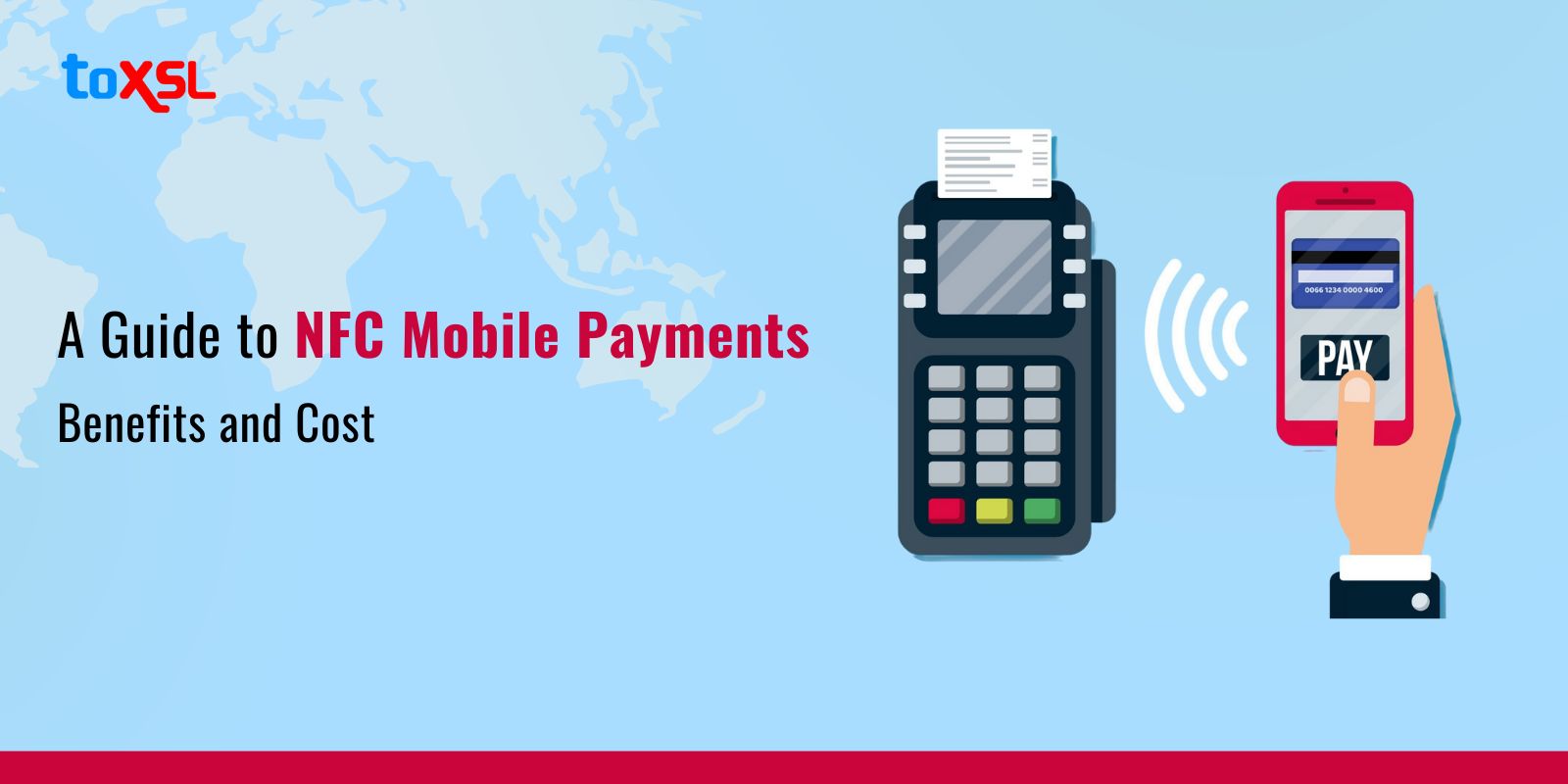The world is changing and so are our payment methods. Today, we prefer ways that allow us to go cashless, making payments digitally. Businesses use less and less cash, making credit cards and mobile wallets very common. But there's another technology called Near Field Communication (NFC) that is making big changes quietly.
NFC, or Near Field Communication, is a wireless technology that communicates with each other from a short distance. NFC payment is a way of making payment gateway software without touching anything. You can use devices such as smartphones or smartwatches to make safe payments at checkout counters. People like NFC payments because they are easy, fast, and secure for both customers and sellers. In this blog, we will dive deeper into NFC technology and learn how it is changing the ways we make payments:
How do NFC Mobile Payments Work?
NFC (Near Field Communication) mobile payments are a simple way to pay without touching anything. They use wireless technology to send payment information safely between two devices, like your phone and a payment terminal, when they are very close to each other—usually just a few inches apart. Here’s how it works:
Device Setup:
Users need to put their payment information into a digital wallet such as Apple Pay or Google Pay on their phones or smartwatches. You connect your credit or debit card to this app, but it doesn't store your actual card number. Instead, it uses a unique code that keeps your real card number safe.
Initiating Payment:
When you want to pay, you unlock your device using a fingerprint, face recognition, or a passcode. Then, you choose the payment method from your digital wallet and hold your device close to the store's payment terminal. This terminal has to be special too, so it can talk to your device using NFC technology. It only works when your device is very close, which helps keep everything secure.
Data Transmission:
When you hold your device near the terminal, it sends a message asking for payment. Your device responds by sending encrypted information, which means it's scrambled, so only the right people can understand it. This includes a special one-time code that replaces your real card number. Even if someone tries to intercept this information, they can't use it because it's only good for that one transaction. This keeps your payment safe from fraud.
Transaction Completion:
After the terminal gets the payment information, it checks everything and confirms the payment. You'll see a message on your device saying the payment was successful. This whole process happens very quickly, usually faster than using a regular card.You don't need to enter a PIN or sign anything, which makes it easy and convenient for both you and the store.
Main Modes Through With NFC Payments Work
NFC payments work using contactless payment technology. Here are the three main modes via which NFC payments work:
- Peer-to-peer: Any two NFC-enabled devices can exchange data simply by touching each other.
- Read/write: An NFC device can read or write information to it using its NFC tag.
- Card Emulation: This mode makes it easy for NFC devices to act as a contactless payment card.
How much does it cost to develop a NFC mobile payment app?
The cost of an NFC mobile payment app depends on the complexity of your project. In general, the cost to develop an NFC mobile payment app development in USA ranges from $10,000 to $100,000, depending on the business needs. Simple NFC app development includes basic features and the cost can range from $10,000 to $25,000. However, if you want to develop a complex app, the cost can range from $25,000 to 100,000, or more. Also, you can calculate the total cost associated with NFC payment app development by using the formula:
Total NFC Payment App Development Cost = Developers Hourly Rate * Development Time
NFC Payment Examples
NFC payments have shaped the world. The following examples will help you get the clear idea and understand the NFC technology deeply:
- Apply Pay: Customized for iPhones and Apple Watches, NFC payments allow users to make transactions by tapping their devices near NFC terminals. However, card details are stored in Apple Wallet safely using Touch ID or Face ID.
- Google Pay: The Google Pay tap-to-pay feature facilitates safe and secure NFC payments. However, this feature works only for Android phones.
- Samsung Pay: Samsung Pay uses Magnetic Secure Transmission (MST) technology alongside NFC, helping Samsung Pay stand out. This technology allows Samsung devices to copy traditional card strips, making Samsung Pay compatible with older payment systems.
Top Reasons to invest in NFC mobile payment app development in the USA
Wondering why should business invest in NFC mobile payment app development company in USA? Below are the benefits of using NFC technology:
- Ease: NFC-enabled devices can replace cards or cash for buying things. These devices can store many credit cards, so you don't need to carry all your cards in your purse or wallet. Instead, you can use your phone or device like a virtual wallet to pay for things. This makes it easier and more convenient to shop.
- Security: NFC uses a strong secret code to keep your transactions safe. This code is called encryption, and it helps keep your information protected. NFC also uses a system called tokenization. Instead of using your real credit card number, it creates a special code for each purchase. This means the store doesn't see your real credit card number when you shop, so your information stays private and secure.
- Sharing: Sharing things like files or money with friends and family is easy when you use an NFC-enabled device. For example, if you want to send a file to someone else's device, it will be sent quickly if both devices allow sharing. This makes it fast and simple to share things.
- Targeted and Context: Advertisers can send ads to people's devices using NFC. When someone taps on an ad, it can be tailored to what they like or where they are. This makes the ads more interesting and relevant to the person seeing them.
Conclusion:
In conclusion, NFC is a way for devices, like phones, to share information wirelessly, without needing an internet connection, over a brief distance. You frequently see it used for such things as cell charge apps, like Apple Pay, wherein you may pay via way of means of retaining your phone near a reader. NFC is likewise used for such things as unlocking doors or hotel rooms without a key. Businesses additionally use it to proportion records or unique offers with clients who've telephones that help NFC.
NFC doesn't use much power, and experts say it’s safe for people to use. It’s about as safe as other wireless connections you use every day, like Wi-Fi or Bluetooth. However, using NFC can use up your phone's battery faster. However, it is recommended to turn off NFC when you’re not using it.
ToXSL Technologies is a leading app development company in USA focusing on custom iOS and Android solutions. We design and build innovative mobile apps for companies of all sizes, from startups to enterprises. Our expertise includes app design, development, and consulting, ensuring your vision becomes a reality. We're dedicated to delivering high-quality, user-friendly apps that drive results. Let us transform your idea into a successful mobile experience! Get a free consultation today.
Frequently Asked Questions
1. How Secure Are NFC Mobile Payments?
NFC mobile payments are highly secure. They use tokenization, which replaces sensitive card information with unique tokens, and encryption to protect data during transactions. Additionally, biometric authentication (e.g., fingerprint or face ID) provides an extra layer of security.
2. What Devices Support NFC Mobile Payments?
NFC mobile payments are supported by most modern smartphones, smartwatches, and some tablets. Devices must have NFC capabilities and a compatible digital wallet app (e.g., Google Pay, Apple Pay, Samsung Pay) to make transactions.
3. Are NFC Mobile Payments Available Everywhere?
While NFC mobile payments are widely accepted, availability can vary by region and merchant. Major retailers and banks often support NFC payments, but smaller businesses might not have the necessary infrastructure. It's always a good idea to check if a store accepts contactless payments before attempting to use them.
4. What Are the Costs Associated with Using NFC Mobile Payments?
For consumers, using NFC mobile payments typically doesn't incur additional fees beyond standard transaction charges. For businesses, costs include the initial investment in NFC-enabled POS terminals and potential transaction fees charged by payment processors. These fees usually range from 1% to 3% per transaction.


















Share this post on: